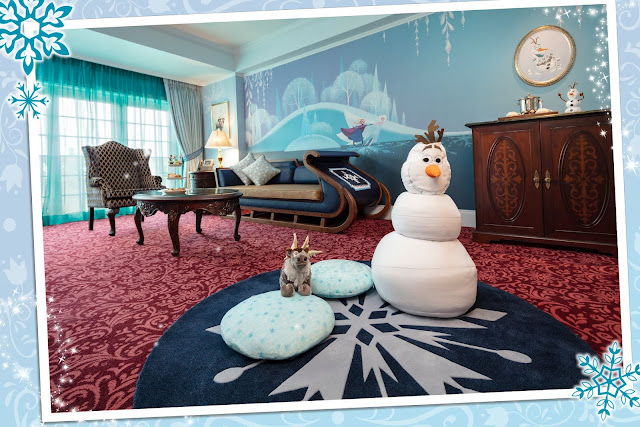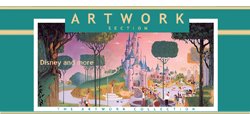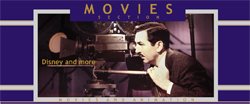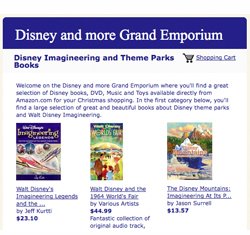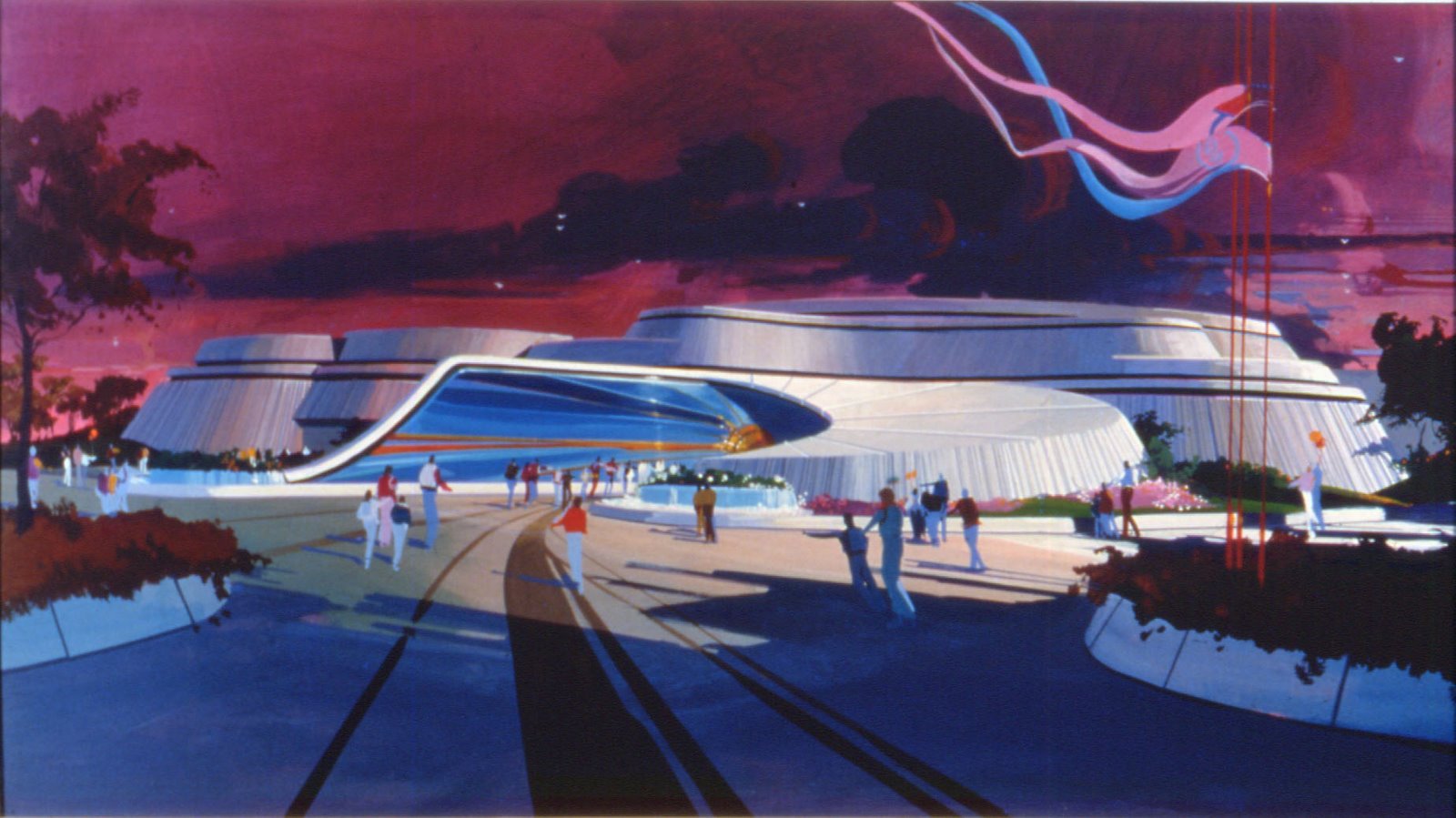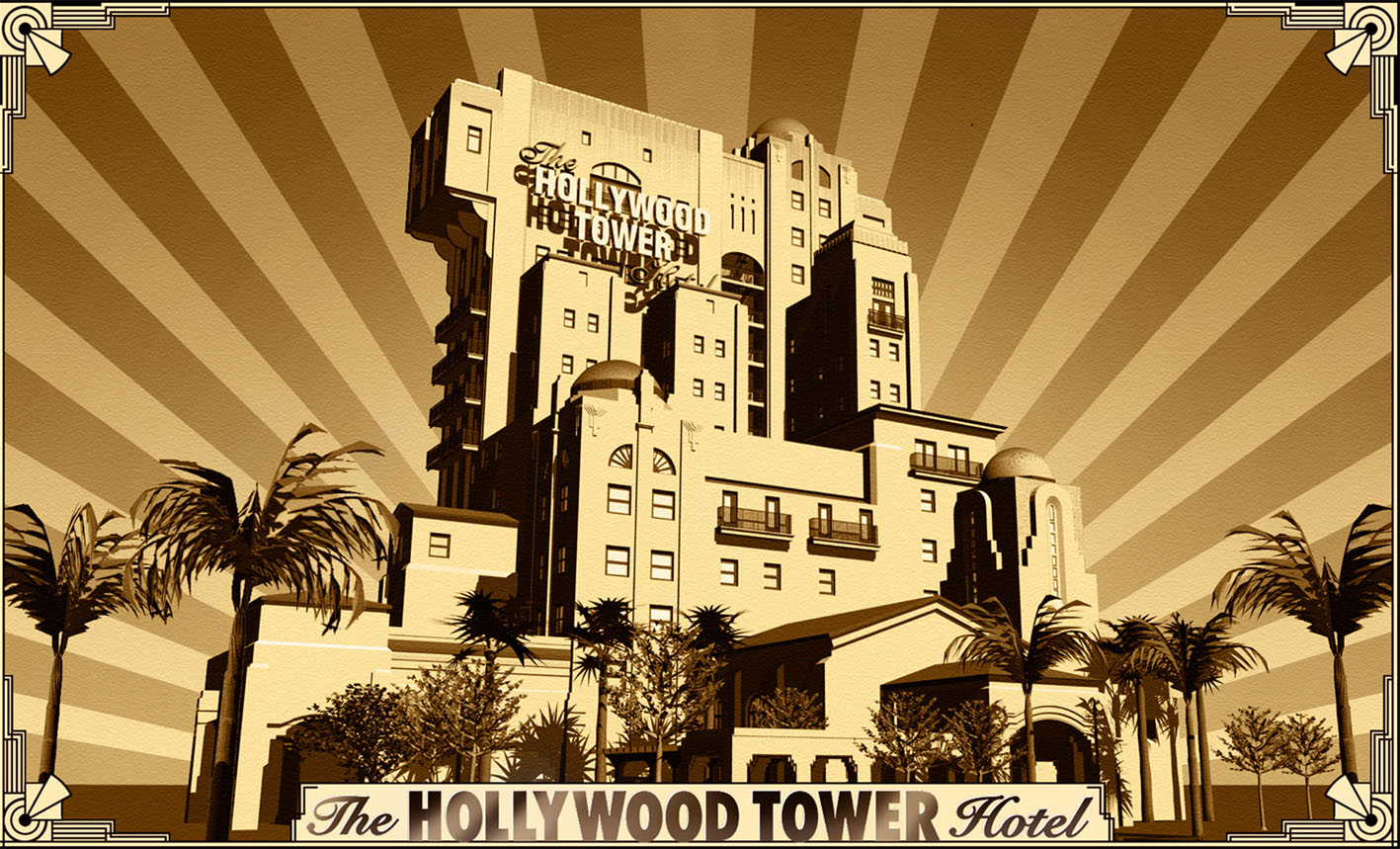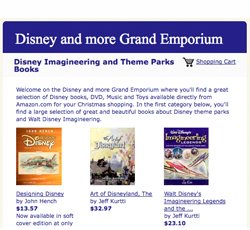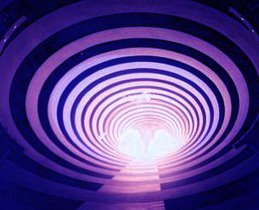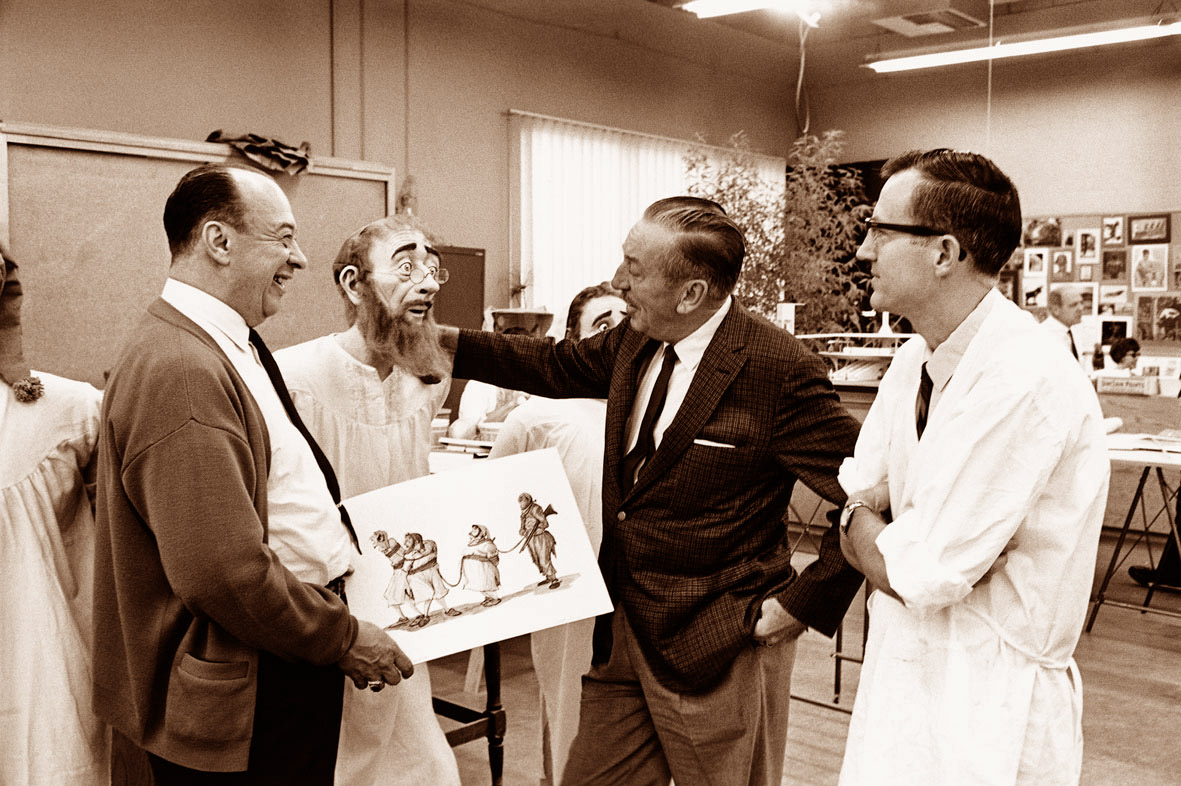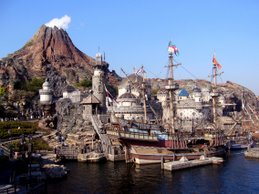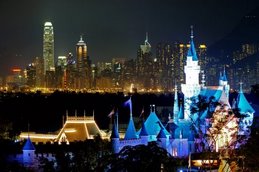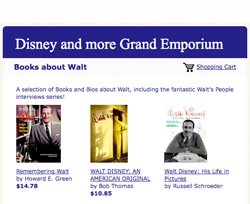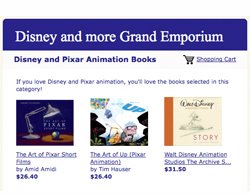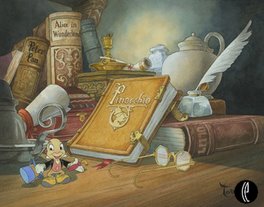
It's Disneyland 63rd Anniversary today and what would be a Disneyland anniversary without Walt? So, to celebrate the event here is a great tribute with the participation of Walt himself, thanks to Jim Korkis, Disney historian and author of the great
"The Vault of Walt" book, who very kindly provided me rare interviews of Walt in which he is talking about Disneyland. I'm posting these interviews below with great pictures of Walt in the park.
This first interview of Walt Disney was done by Fletcher Markle on September 25, 1963, for the Canadian Broadcasting Company, “Telescope” television series.
Fletcher: Where did you originally get the first notion for Disneyland?
Walt: Well it came about when my daughters were very young and I…Saturday was always Daddy’s day with the two daughters. So we’d start out and try to go someplace, you know, different things, and I’d take them to the merry-go-round and I took them different places and as I’d sit while they rode the merry-go-round and did all these things…sit on a bench, you know, eating peanuts…I felt that there should be something built…some kind of an amusement enterprise built where the parents and the children could have fun together. So that’s how Disneyland started. Well, it took many years…it was a…o, a period of maybe 15 years developing. I started with many ideas, threw them away, started all over again. And, eventually, it evolved into what you see today at Disneyland. But it all started from a Daddy with two daughters wondering where he could take them where he could have a little fun with them too.
 Above, Walt in an Autopia car with his daughter and his grand son. Below, Walt talking with children in Adventureland, near Jungle Cruise.
Above, Walt in an Autopia car with his daughter and his grand son. Below, Walt talking with children in Adventureland, near Jungle Cruise.

Fletcher: Who goes to Disneyland? What is the ratio of adults to children as part of the plan of fathers and daughters?
Walt: Oh, it’s four adults to one child. That is we are counting the teenagers as adults. But of course, in the winter time, you can go out there during the week and you won’t see any children. You’ll see all the “oldsters” out there riding all these rides and having fun and everything. Summertime, of course, the average would drop down. But the over all…the year round average…it’s four adults to one child.
 Above, a rare picture of Walt on a Disneyland mule, along with two children. Below, Walt in a Main Street car.
Above, a rare picture of Walt on a Disneyland mule, along with two children. Below, Walt in a Main Street car.

Fletcher: What was the initial cost of Disneyland that first saw the light of day?
Walt: Oh, it goes back so far. I had different cost estimates. One time it was three and a half million and then I kept fooling around with it and it got up to seven and half million and I kept fooling around a little more and pretty soon it was twelve and a half and I think when we opened Disneyland it was seventeen million dollars. Today, it’s going on forty-five million dollars.
 Above, Walt with the parrots of the Tiki Room.
Above, Walt with the parrots of the Tiki Room.
Fletcher: I understand that the next step beyond the audio-animatronics birds (in the Enchanted Tiki Room) has been to do the same kind of programming with human beings.
Walt: Yes, with human beings. Not going to replace the human being…believe me on that. Just for show purposes, because now you take Disneyland down there. We operate fifteen hours a day. And these shows go on…on the hour. And my Tiki bird show goes on three times an hour and I don’t have to stop for coffee breaks and all that kind of stuff, you see. So that’s the whole idea of it. It’s just another dimension in the animation we have been doing all our life.
 Above, Walt looking at a Pirates of Caribbean audio-animatronic, with Imagineer Marc Davis and WDI sculptor Blaine Gibson. Below, Disneyland marquee, circa 1960.
Above, Walt looking at a Pirates of Caribbean audio-animatronic, with Imagineer Marc Davis and WDI sculptor Blaine Gibson. Below, Disneyland marquee, circa 1960.

This next interview of Walt was aired on NBC in 1966.
NBC: Walt, why did you pick Anaheim as the site for Disneyland?
Walt: The Disneyland concept kept growing and growing and it finally ended up where I felt I needed two-three hundred acres. So, I wanted it in the Southern California area, there were certain things that I felt that I needed, such as flat land, because I wanted to make my own hills. I didn't want it near the ocean, I wanted it sort of inland, so I had a survey group go out and hunt for areas that might be useful. And they finally came back with several different areas and we settled on Anaheim because the price of the acreage was right. But there was more to it than that. And that is that Anaheim was sort of a growing area. The freeway projection was such that we could see that the freeway would set Anaheim as sort of a hub. Well, that's how we selected Anaheim.
 Above, Disneyland Main Street Station in the 1950's, and the parking lot behind where is now Disney California Adventure.
Above, Disneyland Main Street Station in the 1950's, and the parking lot behind where is now Disney California Adventure.
NBC: Do you feel Anaheim has lived up to expectations?
Walt: In every way, the city fathers have been wonderful. They've given us wonderful cooperation right from the start and they are still cooperating.
NBC: What has been your biggest problem?
Walt: Well, I'd say it's been my biggest problem all my life - it's money. It takes a lot of money to make these dreams come true. From the very start it was a problem of getting the money to open Disneyland. About 17 million dollars it took. We had everything mortgaged, including my family. We were able to get it open and for ten or eleven years now we've been pouring more money back in. In other words, like the old farmer, you've got to pour it back into the ground if you want to get it out. That's been my brother's philosophy and mine too.
 Above, Walt and WED Imagineer John Hench in front of the Carnation Plaza model. Below, Walt in front of It's a Small World facade during its construction.
Above, Walt and WED Imagineer John Hench in front of the Carnation Plaza model. Below, Walt in front of It's a Small World facade during its construction.

NBC: What plans for the future do you have at Disneyland?
Walt: There's a little plaque out there that says, "As long as there is imagination left in the world, Disneyland will never be complete." We have big plans. This year, we finished over $20 million in new things. Next June, I hope, we'll have a new Tomorrowland; and starting from the ground up, building a whole new Tomorrowland. And it's going to run about $20 million bucks.
 Above, a view of Disneyland New Tomorrowland in the late 60's.
Above, a view of Disneyland New Tomorrowland in the late 60's.
NBC: What steps have you taken to see that Disneyland will always be good, family entertainment?
Walt: Well, by this time, my staff, my young group of executives are convinced that Walt is right, that quality will win out, and so I think they will stay with this policy because it's proven it's a good business policy. Give the public everything you can give them, keep the place as clean as you can keep it, keep it friendly - I think they're convinced and I think they'll hang on after - as you say, "after Disney."

This next interview of Walt was done by Hooper Fowler for LOOK magazine, January 1964.
Fowler: How often do you go to Disneyland now, Mr. Disney?
Walt: Oh, I might average once a month. Most of my interest in Disneyland is planning and improving it, and I do a great deal of that here at the studio. So I only go down to check on things now, to see what ought to be done for the coming year. It’s pretty hard to get around Disneyland when people are there. I mean, they’re friendly, they’re wonderful, and I love to meet them, but I can’t stand still long because I’ll…oh, I don’t mind giving autographs. I think it’s wonderful that they do want your autograph. But when I’m at Disneyland, if I stop to sign one autograph, before I can get that signed, there are some more up there, and it accumulates quite a crowd, and it always makes it awful hard to get away.
So when I go through Disneyland today, I walk fast, and it isn’t much fun. So I go down with my staff when Disneyland is closed, and we go through everything. Or I go down when there is a big crowd, a very big crowd, and I walk very fast and watch every part of it and find out where we need to improve our crowd control conditions to make it easier for people to get around and our shade areas and all the problems that we have in the summer when we have the half million plus people a week.
So, mainly my interest in Disneyland has been building that thing, in keeping it alive and keeping it fresh and keeping it successful by doing these things. So most of my fun comes from that end of it.
 Above, Walt watching a DL worker in Main Street. Below, Walt checking on of the Peter Pan's Flight vehicle.
Above, Walt watching a DL worker in Main Street. Below, Walt checking on of the Peter Pan's Flight vehicle.

Fowler: Will there ever be another Disneyland?
Walt: I think there will only be one Disneyland as such. Now that doesn’t mean that in some areas we might not develop certain projects that would be compatible to that area, that might very well tie in certain historical themes of the area of things like that and we are considering things of that sort. Most of the people coming to Disneyland, the big percentage is coming west of the Mississippi and more or less the Pacific coast. The great center of the population is east of the Mississippi and it’s possible that we could go to these areas with certain things without in any way depreciating the individuality of Disneyland itself. But there will only be one Disneyland as such. It’s quite a chore to keep Disneyland going. It’s like a big show you’ve got to keep on the road, you know. You’ve got to keep it fresh and new and exciting. And when people come back, you always want to have something new they hadn’t had a chance to see before. And we feel a keen responsibility to the customer there. They aren’t customers, we call them paying guests.
 Above, a great aerial view of Disneyland, circa 1960. Below, a beautiful shot of Fantasyland more or less at the same time.
Above, a great aerial view of Disneyland, circa 1960. Below, a beautiful shot of Fantasyland more or less at the same time.

This next interview of Walt was done by journalist Pete Martin for the Saturday Evening Post, Summer 1956.
Pete Martin: Let's talk a little about Disneyland and how it's so different from other amusement parks.
Walt: It really takes a person more than a day to see the park without exhausting themselves. And as I get these new things in, it's going to take more time. It's one of those things that people who come in here for the first time and everything's there and they sort of make a hog of themselves, you see? Well, a lot of people come back the third time and just like to sit and listen to the band, see the horses going around. I like to go down and sit by the river and watch the people.
 Above, a picture of the Mark Twain sailing on Frontierland river, in the early days of Disneyland.
Above, a picture of the Mark Twain sailing on Frontierland river, in the early days of Disneyland.
Walt: Chewing gum sticks up things so we don't sell it. And peanut shells. We sell the unshelled. But shelled peanuts, they just crumble them and throw them all over the place. And nothing with round sticks. People trip on them. The ice cream bars got flat sticks and I won't sell any of this spun candy because the kids get it and get it all over everything and people get it on their hands.
No liquor, no beer, nothing. Because that brings in a rowdy element. That brings people that we don't want and I feel they don't need it. I feel when I go down to the park I don't need a drink. I work around that place all day and I don't have one. After I come out of a heavy day at the studio sometimes I want a drink to relax.
 Above, Walt, relaxing on a bench of Disneyland Town Square.
Above, Walt, relaxing on a bench of Disneyland Town Square.
Walt: When it comes to Disneyland, I feel I've given the public everything I can give them. My daughter, Diane, says that I spend too much time around the house talking about how I can give them more for their money when they come to the park. You've got to build. You've got to keep it clean. You don't want to walk in a dirty toilet. I won't have 'em. My toilets are spic and span. And you know another thing, I have to have police so there's no child molesters there. I've got plainclothesmen. They can leave their kids to run around and I have safety inspectors. It's run in a high class manner and I have a high class clientele. The people who go to the park are from all walks of life but they look like solid Americans. That's pretty high class.
 Above, Walt with Richard Nixon and family at the opening of the Disneyland Monorail. Below, Walt with India prime minister Nehru, at the end of the 1950's in a Jungle Cruise boat.
Above, Walt with Richard Nixon and family at the opening of the Disneyland Monorail. Below, Walt with India prime minister Nehru, at the end of the 1950's in a Jungle Cruise boat.

Pete Martin: One of the things we should cover is to knock off that rumor that Disneyland's expensive to come to.
(Even in 1956, Walt was getting complaints about the high cost of getting into Disneyland. An adult ticket cost a dollar--nine cents of which went directly to taxes--and a child admission cost fifty cents. On top of that, people bought individual tickets for rides. Walt introduced the concept of ticket books so you got more rides for the money you spent on the book than if you bought each ride individually.)
Walt: Oh, no. Not at all. That's an old hat thing. You hear it from some people because they don't know what else to say.
By the time this article comes out, I'm raising it to two dollars because I'm adding all these new rides. And to extend my ticket book to take care of the rides, I'm putting this to ten rides for two dollars. Figure it out. It averages twenty cents a ride, doesn't it? It would cost an adult three dollars and a junior two dollars and fifty cents to get in and get ten rides. If they don't want that, they can pay their buck and pay their fifty cents for their kid and they can come in. They can sit on the park benches, take up the space, dirty up my toilets, litter up the street. They can do all of that if they pay their dollar-fifty. They can ride as they want to. They can sit around and hear my band; they can visit my free shows. They can do all that and more for their dollar-fifty.
 Above, Walt in the locomotive of the Tomorrowland Viewliner. Below, Walt in a vehicle of the Mine Train through Nature Wonderland attraction.
Above, Walt in the locomotive of the Tomorrowland Viewliner. Below, Walt in a vehicle of the Mine Train through Nature Wonderland attraction.

Walt: You can't go in a state park without paying that. See, you've got to pay something. You pay so much a head or so much a car to go in a state park. We even have to pay government tax on admission. So it's really ninety-one cents to get in. Now that's what it amounts to. You can't go to the circus for that. I tell you the complaint about the prices are malicious. Los Angeles is made up of a lot of different characters. How do I know they might not be more interested in some other thing like Marineland? Or some other type of amusement that is competitive. We are competitive, too. Who knows? But there's no foundation for some of these complaints about price. When people make that remark to me, it just sounds to me like they heard it somewhere and they don't know what else to say. How can they compare Disneyland prices with anything else because there is nothing else like it.
Well, you take you children to Disneyland and for a dollar and a half they get in and spend a whole darn 13 hours if they want to. Now, if you want to go in and buy them expensive toys or you want to buy them bathing suits or your wife happened to go along and sees a wonderful woolen skirt that costs $30. Well, people come out and spend all that money. But they don't think twice of going down to Bullocks Wilshire and spending that much on a skirt. If you go into a Broadway Department Store, you can go in and spend $25 or $30. I'm not insisting people buy things but I want to give them the opportunity.
 Above and below, Walt with audio-animatronics of the Jungle Cruise.
Above and below, Walt with audio-animatronics of the Jungle Cruise.

Walt : So I have to keep improving on ideas. On the jungle ride, I want to get more animation in the animals. I want to really fix it. My monkeys have gone to pot. And I want new monkeys. I'm going to take them out Monday because I'd rather not have them in there looking like that.
 Above, probably the most famous picture of Walt at Disneyland. Walt is entering Fantasyland walking through Sleeping Beauty Castle - and not exiting to Central Plaza as sometime it is thought. The picture was shot by Renie Bardeau the same photographer who shot Walt's final photo at Disneyland that you can see below
Above, probably the most famous picture of Walt at Disneyland. Walt is entering Fantasyland walking through Sleeping Beauty Castle - and not exiting to Central Plaza as sometime it is thought. The picture was shot by Renie Bardeau the same photographer who shot Walt's final photo at Disneyland that you can see below

Happy 63rd Anniversary Disneyland and there is more celebration from D&M on the
D&M Facebook page where i've posted dozens of awesome LIFE Magazine pictures shot by LIFE photographers on Disneyland opening day, July 17, 1955,
so jump HERE!
And don't miss Jim Korkis "The Vault of Walt" a fantastic book series
available on Amazon HERE, in which Jim weaves timeless tales and fascinating secrets about the "lost" world of Disney thanks to over thirty years of his personal interviews with Disney animators, Imagineers and associates as well as long forgotten documents and many years of research. It really is a must-have!
Pictures: copyright Disney
All my thanks to Jim Korkis for these great interviews!










